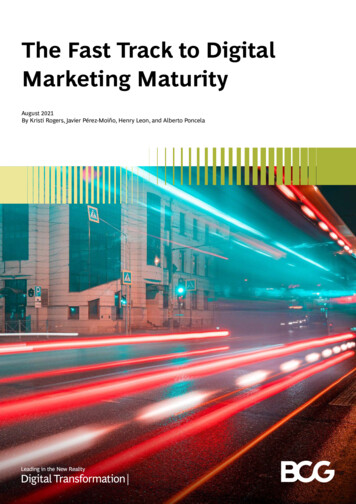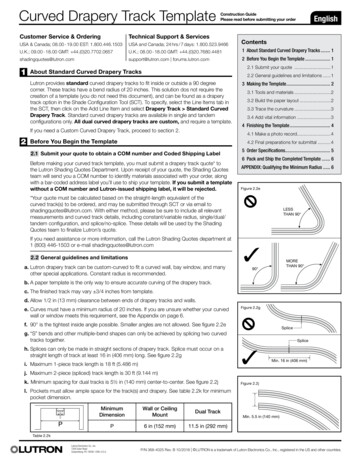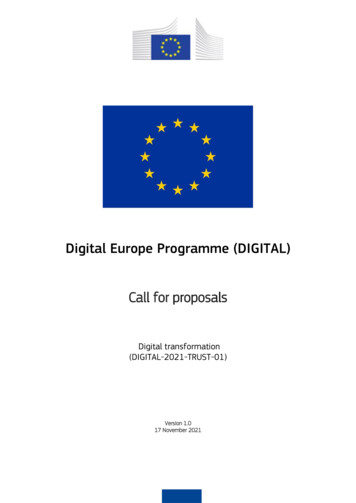
Transcription
The Fast Track to DigitalMarketing MaturityAugust 2021By Kristi Rogers, Javier Pérez-Moiño, Henry Leon, and Alberto Poncela
Boston Consulting Group partners with leadersin business and society to tackle their mostimportant challenges and capture their greatestopportunities. BCG was the pioneer in businessstrategy when it was founded in 1963. Today,we work closely with clients to embrace atransformational approach aimed at benefiting allstakeholders—empowering organizations to grow,build sustainable competitive advantage, anddrive positive societal impact.Our diverse, global teams bring deep industry andfunctional expertise and a range of perspectivesthat question the status quo and spark change.BCG delivers solutions through leading-edgemanagement consulting, technology and design,and corporate and digital ventures. We work in auniquely collaborative model across the firm andthroughout all levels of the client organization,fueled by the goal of helping our clients thrive andenabling them to make the world a better place.Commissioned by
Contents03 W here Digital10 T he Fast TrackMarketingto MaturityMaturity Is GoingToday Accelerator 1: First-Party Data Accelerator 2: End-to-End Measurement08 T he TrendsDriving DigitalEngagement Accelerator 3: Agile Performance Loops Accelerator 4: New Skills and Resources18 Moving Forward20 A bout theAuthors
More Digitally Mature Brands Obtain Tangible ResultsAverage18 ppRevenue increase( 2 pp)11Average29 ppCost savings( 16 pp)12xLikelihood of marketshare growth2Source: BCG analysis.Note: pp percentage points.Comparison with 2019 research results.1“Market share” refers to a comparison with brands’ industry peers.22 THE FAST TRACK TO DIGITAL MARKETING MATURITY
Where DigitalMarketingMaturity IsGoingBOSTON CONSULTING GROUP For CMOs and their digital marketing organizations, thechanges of the past 18 months have come fast, andtheir full impact has yet to be felt. Two big shifts standout. The pandemic compressed several years of digitalmarket evolution into a few months as consumers racedonline to do everything from purchasing daily necessitiesto seeking medical treatment. At the same time, the datastream provided by third-party cookies—one of the criticalsupports of precision digital marketing—began to dwindleas the industry and regulators reacted to growing concernsabout privacy. Meanwhile, consumers’ expectations formore customized, even personalized, outreach and inter action continued to grow.3
Many companies have responded to these sea changeswith speed and agility. Others have been slower to react.The big difference is the extent to which each company hasadvanced its digital marketing maturity.New BCG research in 2021 has found that more maturebrands increased their sales by an average of 18 percentage points more than their less mature peers (2 more thanin 2019) and boosted cost efficiencies by an average of29 percentage points (16 more than in 2019). These companies outperformed on market share as well, with morethan twice as many digitally mature brands increasingtheir share in the past year—by 3 percentage points ormore on average—than low-maturity brands. (SeeExhibit 1.)In the case of digital marketing, the race belongs to theswift, which means that less mature companies need toaccelerate their efforts to catch up. Companies that haveadvanced quickly are reaping the rewards of those gainswhile companies that are treading water or making onlygradual headway are falling farther behind their moremature competitors.CMOs understand the potential upside of digital marketingmaturity. The diminishing role of third-party cookies underscores the situation’s urgency. Still, CMOs encounter mul tiple challenges as they try to boost their organization’smaturity. The curve gets steeper as it rises, increasing thedifficulty of moving to the next level. For many large companies, generating the momentum needed to carry themup the curve requires an organization-wide effort that oftenmust surmount internal hurdles. C-suite leadership andconcerted teamwork across senior management are keycatalysts and drivers of success. More than 80% of themost digitally mature brands say that they have CEO sponsorship for data-driven marketing initiatives, whereas lessthan half of other brands do. As we have shown in the past,having the necessary enablers in place provides a foundation for making rapid, lasting progress.In 2019, BCG research found that companies self-dividedinto four levels of digital maturity: nascent, emerging,connected, and multimoment. About 90% of the brandsincluded in that survey split almost equally between theemerging and connected categories.Exhibit 1 - Companies with High Digital Maturity Are More Than Twice asLikely to Grow Market ShareBrands that grew their market share between from 2020 to March 2021 (%) 2XGrew market share1540Did not grow market share8560Low-maturity brands High-maturity brands grew theirmarket share by 3 percentage pointsmore than low-maturity brands did,on average.High-maturity brands Source: BCG-Google maturity assessment (survey conducted from March 26 to April 14, 2021).Note: “Market share” refers to a comparison with brands’ industry peers. Survey question: “How much has your market share changed during thelast year? Please specify estimated positive or negative percentage point change—e.g., from 30% market share to 40% market share is 10 percentage points.”Nascent and emerging brands.1Connected and multimoment brands.24 THE FAST TRACK TO DIGITAL MARKETING MATURITY
Our latest research, conducted in 2021, found areas ofsignificant improvement: 13% more companies had movedinto the top two digital marketing levels, and the multi moment category, in particular, registered a big jump from2% to 9%. But most companies are still trying to break outof a muddle in the middle categories. (See the sidebar “AMuddled Maturity Curve.”)In the handful of years since we introduced the model thatwe use for assessing maturity—including the enablers thatdefine digitally advanced marketers—numerous consumer- facing companies and their tech and advertising partnershave adopted the model. (See Exhibit 2.) In the midst ofthe changes taking place, our new study isolated fourspecific accelerators that stand out as the principal driverson the fast track to maturity today: Building a virtuous cycle around first-party data Developing a true end-to-end measurement capabilityacross channels, using predictive models Setting up agile performance loops based on a test-andlearn approach Securing access to new skills and resourcesThese accelerators are enabling the companies that adoptthem to ascend the maturity curve much more quicklythan their peers and competitors.One additional critical factor demands special attention:consumer trust. BCG has been conducting research andwriting about online privacy and consumer trust for thebetter part of a decade. As early as 2013, we pointed outthat trust is fragile and elusive. More recently, in May 2020,we highlighted the issue of trust as a crucial element incompanies’ ability to gain access to first-party data withtransparency and use it to enhance their value proposition.As we noted then, consumers are much more likely toshare data with companies that they trust; they mainly justwant those companies to ask. At its core, data best practiceserves a two-way value exchange: the company gains theability to deliver a better customer experience and more- effective marketing, and the customer gains useful information, assistance, and offers. This puts trust and value atthe center of effective digital marketing.Companies that maintain their focus on customer valueand trust—and combine C-suite leadership with the fouraccelerators—will find themselves pointed toward theshortest and quickest route to improvement.Exhibit 2 - Four Accelerators, Together with Customer Value and Trust,Speed Digital Marketing MaturityAutomation andintegrated techil eteam ingActionablemeasurementsta n d f a il -f ac ultureVirtuous cyclearound first-partydata3Agile performanceloops based ontest-and-learnOrganizationalTechnicalNew shiprs2021 enablers and acceleratorslsskilistialecStrategicpartneDigital marketing rvalue andtrustAutomation andintegrated techAgil eteam ingEnd-to-endmeasurementsta n d f a il -f ac ulture4New skillsandresourcesAcceleratorSource: BCG analysis.BOSTON CONSULTING GROUP 5
A Muddled Maturity CurveBCG and Google have been tracking the digital maturity ofadvertisers, along with related issues such as the use offirst-party data, for several years. We have collaboratedmultiple times to study various aspects of digital marketing. Over this period, there has been a significant acceleration in such marketing among the most mature digitalbrands, and the COVID-19 pandemic has altered consumerbehavior, complicating life for marketers.In 2019 we assessed the digital maturity of about 180marketers around the world and found that companies fellinto four categories, with almost 90% of them grouped inthe middle two: Nascent. Marketing campaigns use mainly externaldata and direct buys, with limited linkage to sales.6 Emerging. Marketers make some use of owned data inautomated buying, with single-channel optimization andtesting. Connected. Companies rely on data integrated and activated across digital channels, with demonstrated linkageto ROI or sales proxies. Multimoment. Organizations optimize dynamic execution across channels throughout the customer journey toachieve business outcomes.In 2021 we thought it was time to refresh our perspectivein light of marketplace changes and technology advances.In this round of research, which involved 67 European,Middle Eastern, and African brands in ten countries, about84% fell into the emerging and connected categories, alongwith about 7% nascent players and about 9% multimomentfirms. (See the exhibit.)THE FAST TRACK TO DIGITAL MARKETING MATURITY
The limited progress on this front may reflect the difficultythat companies have with digital transformations generally.Separate BCG research has shown that 70% of these programs fail to achieve their objectives. The four acceleratorshighlighted in this report can help companies radicallyimprove their chances of success by speeding the embedding of the digital enablers that our 2019 marketing research identified as being critical to increasing digitalmaturity.The research consisted of multiple qualitative and quantitative components: Workshops and interviews to define new hypotheses fordigital marketing maturity 25 “belief audits” with experts, agencies, and brands Surveys of senior executives of 67 brands in six industries—automotive, retail, consumer goods, finance,technology and telecommunications, and travel More than 15 in-depth interviews that primarily focusedon examples of best practiceBrands Have Made Progress on Digital Maturity Since 2019DDM mergingLow MaturityAll Industries medianConnectedMultimomentHigh MaturitySurveys in 2019 studySurveys in 2021 YTDSource: BCG analysis.BOSTON CONSULTING GROUP 7
The TrendsDriving DigitalEngagement8 Each of the three principal trends driving the need forcompanies to accelerate their digital marketing has itsown shape and impact. But taken together, they areraising the stakes for less mature marketing organizationsto take action. (See Exhibit 3.)People have gradually been doing more online for years,but the pandemic boosted both the number of onlineusers and the extent of their activities. Research showsthat in sectors ranging from financial services to consumergoods more people are doing more discovery, familiarization, validation, and buying online. These include peoplewho have never used digital channels for commerce before.THE FAST TRACK TO DIGITAL MARKETING MATURITY
Exhibit 3 - Three Trends Are Influencing Digital EngagementDemand volatility10yearsof e-commercegrowthinPersonalizationPrivacy regulations driven byconsumer expectations78%80%Online consumers are more likely topurchase at e-commerce sites thatoffer personalized experiencesConsumers are cautious aboutsharing data, but they still expectpersonalization8weeksApril and May 2020 saw more e-commercegrowth than the previous decade did,with digital sales as a percentage of allretail jumping from 16% to 27% in the USand from 18% to 30% in the UKSources: Avioos; Bank of America; US Department of Commerce; ShawSpring Research, 2020; UK Office of National Statistics, 2020; BCG researchand analysis.In the years before COVID-19 hit, a rapid expansion ofpersonalization in marketing was already underway—andsince then, the consumer expectations that personalizedoutreach creates (for both digital and offline engagement)have been growing faster than ever. In response, leadingbrands are finding ways to adapt as technology enablesnew capabilities. For example, advanced marketers arestarting to use AI-generated creative content to deliverrelevant messages to segmented customers at scale.Although customers expect more relevant, personalizedmarketing, they remain cautious about sharing their data.And as consumer privacy concerns evolve, regulatory shiftsand new industry data practices, such as Apple’s rules foridentifying users to advertisers, are following.All of these changes are elevating the importance of solutions such as alternative technologies and reliable, plentiful first-party data for marketers. The new landscape willnecessitate new tradeoffs and will alter how companiescan most effectively engage with customers and consumers online.These are not passing trends. They will continue to gainspeed going forward. Companies that lack the digital capability to react quickly will lose ground to those that have setthemselves up to move quickly.The loss of third-party data is a relatively recent development, but we foresee a day when third-party cookies will bea tool of the past, removing a key structural component ofcountless precision digital marketing campaigns.BOSTON CONSULTING GROUP 9
The Fast Trackto MaturityTodayThe six digital marketing enablers that we identifiedin 2019 remain critical to digital success. But inresponse to the changes now taking place in consumer behavior and marketplace dynamics, advancedmarketers are focusing on specific ways to augment andexpand their digital capabilities. Our most recent research,which included 25 “belief audits” with experts, agencies,and brands, as well as a quantitative analysis of input fromsenior marketing executives, identified four acceleratorsthat today’s fast-maturing brands apply: Build a virtuous cycle around first-party data in order toaddress privacy concerns and maintain customer valueand trust. Develop a true end-to-end measurement capabilitythat includes predictive models to replace data fromthird-party cookies. Set up agile performance loops based on a test-andlearn approach to break down silos and be better prepared to address future demand volatility. Secure new skills and resources to help ensure continuous improvement.10 THE FAST TRACK TO DIGITAL MARKETING MATURITY
Our statistical modeling shows that these acceleratorshave become the primary determinants of digital maturity.Although our analysis also shows that the two technicalaccelerators have twice the impact of the two organizational accelerators, the four complement one another andspeed overall maturity. For that reason, top digital marketers work on them together. End-to-end measurement, forexample, is essential to building an effective first-partydata cycle as well as to driving agile performance loopsand testing new hypotheses. In the same vein, a companywill find it impossible to implement the first three accelerators unless it has the proper skills and resources in place.Accelerator 1: First-Party DataIn the past year or two, privacy concerns and regulatorychanges have increased the importance of first-party data,which helps companies keep value and trust at the centerof the customer relationship by providing a transparentresponse to consumer and regulatory concerns. In addition, our research has shown that companies that link allof their first-party data sources can generate 1.5 times theincremental revenue from a single ad placement, communication, or outreach, and double the improvement in costefficiency over companies that have more limited data integration capabilities.Furthermore, our research demonstrates that brands thatdevelop the four accelerators in parallel encounter smallergaps among them and reach higher stages of overall maturity more quickly. For example, for companies that aremoving up the curve from emerging to connected or fromconnected to multimoment, the gaps between acceleratorsare 25% to 30% smaller than those for companies that arestuck in place.The most important objective is to gain and maintainaccess to the data itself. Sophisticated marketers in theconnected and multimoment categories reinforce valueand trust by pursuing a three-step process to build virtuousdata cycles:Even within the same stage of maturity, brands that showgreater balance in developing the four accelerators generate better business results. High-maturity brands thatmanage the development properly can gain an additional2 percentage points of revenues and efficiencies comparedwith their peers. At the other end of the maturity curve,95% of companies tend to prioritize developments inend-to-end measurement and agile while deemphasizingfirst-party data and skills and resources. For two-thirds ofthese companies, the lack of progress on the latter twoaccelerators holds them back by a full maturity step. Value. They develop a compelling value proposition forthe consumer or customer exchange.Climbing the digital maturity curve takes time and hardwork, but progress yields results along the way, which buildsmomentum. At all levels of maturity, active and visibleC-level leadership is a must, as is cultivating and preserving customer value and trust at the core. To clarify whatneeds to happen and when, we have devised a roadmap forimplementing the four accelerators. (See Exhibit 4.) Boththe technical and the organizational requirements forfurther progress become increasingly sophisticated as companies become more mature. Strategy. They define a clear strategy for the first-partydata needed. Testing. They leverage multiple iterations of testing withconsumers to perfect campaign execution and learnwhich experiences most effectively promote the value- consent exchange.The process also has an important technology component.Most multimoment companies use marketing technologyeffectively, and nine out of ten marketers say that first- party data is important to their digital marketing programs.But less than a third have mastered accessing and integrating data across channels, and very few are good atusing data to create better outcomes for customers. Thisdoes not mean it cannot be done. As a retail executive putit, “Being able to link online data to offline data was arelatively easy process that was up and running in aboutfour months. Customer data platforms allowed us not tobe so reliant on cookie technology.”Using first-party data in this way is a fairly new priority formarketers, and maintaining customer trust is as importantas gaining it in the first place. Salesforce.com’s 2020 Stateof the Connected Customer survey found that 60% ofcustomers see a “major need” for businesses to improvetheir trustworthiness and 32% see a “moderate need.” Fourout of five customers want companies to use technologyethically, even if doing so reduces profits.So far, few advertisers have gone the extra mile and established privacy-ready and ethical data governance processesto reinforce their value propositions to the customer. Onlyabout 50% of multimoment companies and 20% of connected companies have policies and processes in placeBOSTON CONSULTING GROUP 11
Exhibit 4 - A Roadmap to Digital MaturitySet The FoundationFirst-partydataBuild Connections Understand current data Ensure basic data qualityMake Every Moment Matter Acquire first-party databy building trust Link online data withCRM Set up a cross-functionalprivacy teamTechacceleratorsEnd-to-endmeasurementAgile performanceloops Connect goals and alignobjectives betweenbusiness and marketing Ensure that key functionswork togetherOrganizationalacceleratorsNew skillsand resources Define appropriatetracking in place Use predictive marketingattribution models Fill skill gaps withstrategic partners Physically or virtuallyco-locate cross-functionalteams to ensure dataflows Establish a balance ofinternal and externalskills Build a compelling storyacross the entirecustomer journey forfirst-party data Develop end-to-endmeasurement(cross-channel andcross-device) Use predictive models(uplift test, modeledconversions) to completejourney and fill data gaps Embed agile teams and afail-fast culture Use digital signals(media, context, andfirst-party andsecond-party data) toreact to changes Upskill through learningprograms Develop retentionprogramsContinuous C-suite sponsorship throughout the digital journeyNascentEmergingConnectedMultimomentSource: BCG analysis.that govern the use of personal data and are supported bycross-functional privacy teams that look into individualcases. (See Exhibit 5.)Leaders in advanced organizations ensure that their usesof first-party data comply with applicable regulations andwith their own policies, and they build capabilities aroundthe trust-for-value exchange. They make it easy for customers to opt in to communications across channels, by providing a straightforward, candid, and customer-friendlyconsent process. They then leverage a customer dataplatform to safely manage the data they collect. “We havemore than 13 million members in our loyalty program,”said a travel company executive. “Each piece of information sent has to reinforce trust. We focus on the messageswe provide and the value proposition we provide with eachof them.” A banking executive told us, “Whenever dataneeds to be transferred, there is an assessment with aninternal cross-functional team to analyze possible risksand how to minimize them. We have an internal process toensure all uses of data follow privacy requirements.”12 Consider how a major bank in South Africa benefited froma first-party data strategy. “We needed a clear understanding of what new and existing customers were looking for,”said the bank’s top digital marketing executive. “We aimedto get more personalized and relevant. Our primary goalwas more efficient digital marketing outreach with moreproduct-specific touch points. We realized that the bestway to do that was to design an integrated first-party dataaudience strategy for both online and offline.”The bank needed a clearer understanding of what new andexisting customers were looking for, so it could sharpen thepersonalization, relevance, and product specificity of itscampaigns. It designed an integrated first-party data strategy across both online and offline sources. Using machinelearning and predictive lifetime-value models, the banksegmented customers according to the bank’s productrange. The segmentation enabled it to create a more personalized customer experience, from creative treatmentsto landing page.THE FAST TRACK TO DIGITAL MARKETING MATURITY
Exhibit 5 - Mature Brands Build a Virtuous Cycle Around First-Party DataDistribution and maturity gaps for first-party dataLow-maturity featuresBasicMatureHigh-maturity featuresLack a strategy to overcome theobsolescence of third-party dataand to incorporate first-party dataBuild trust with customers on thebasis of A/B testing in order tocapture first-party dataHave no or limited linking ofcustomer dataLink all or most customer data(including online and offline) usedin marketing activationLack a team dedicated tomanaging privacy requirementsHave strategic and privacy-ready dataprocesses overseen by a dedicatedcross-functional privacy teamAverage maturity, as reported in researchNascentExpected score per maturity levelEmergingConnectedBasic gaps in maturityMultimomentSource: BCG analysis.The bank also applied a test-and-learn approach, anotherof the four accelerators. “At the beginning of the journey, itwasn’t easy,” the executive said. “For each iteration, weneeded to make sure that we were compliant from a privacy perspective and that we followed the correct processes.”The strategy led to 89% more online leads and 300% betteruser engagement while also increasing the bank’s efficiency. Revenues rose significantly and costs dropped. Afterdemonstrating the value of the first-party data strategy, thebank rolled it out across all of its international markets.Companies that have not yet invested in understandingtheir current sources of data and ensuring basic dataquality as a foundation for other capabilities need to startnow. More digitally mature organizations may need toinvest further in securing all sources of first-party data andestablishing a cross-functional data privacy team. All successful brands will build a compelling story for customersacross the entire purchasing journey as underpinning forthe trust-value exchange of first-party data.Accelerator 2: End-to-End MeasurementThe ability to measure the impact of different types ofinteractions with customers along the purchasing journey,regardless of channel, is a holy grail of digital marketing.Brands need an effective measurement system to continuously optimize the value exchange with customers, andthis requirement will become all the more important asdata becomes harder to acquire over the next few years.BOSTON CONSULTING GROUP The first step toward effective end-to end measurement isto establish a consistent set of KPIs (common objectivesshared across multiple channels and marketing teams) forassessing impact. Aside from those in the nascent cate gory, most brands (78%) have a limited set of metrics— typically five to ten—that inform their marketing investment decision making and allocations across categories,brands, markets, lines of business, and media channels.More advanced companies summarize the relevant reporting on a strategic scorecard or dashboard that supportsdecision making across various strategic and tacticaldimensions.With the impending loss of third-party data, precisionmarketing must evolve toward more predictive marketing.Establishing attribution for purposes of advertising andpromotion budget allocation requires end-to-end measurement encompassing channels, devices, and predictivemodels that use advanced analytics to bridge gaps in data(predominantly caused by the loss of third-party cookies).Predictive models help companies gauge the probabilityvalue of the different occasions when a customer or potential customer comes into contact with the brand, which inturn enables ROI optimization. A retail executive for anItalian company said, “Attributions based on predictivemodels are of high importance and add a lot of value,providing information that fills the gaps created by privacyrestrictions or multichannel interactions. They enable ourcompany to optimize ROI.”13
Accelerator 3: Agile Performance LoopsEven so, some of the more advanced marketers in ourstudy have not built this capability. Only 42% of multi moment companies and 36% of connected companiesleverage predictive models.All brands, including multimoment ones, have room forimprovement in end-to-end measurement. (See Exhibit 6.)Customers vary widely in their interests, motivation, andbehavior (among other factors). In our work on personalization campaigns, we have found that companies tend tofocus on overall campaign effectiveness, striving for solutions that work well on average. As a result, they fail toidentify pockets of variety among their customers, which iswhere the real value of personalized outreach lies. A/Btesting reveals what works best on average, but companiesthat want to build deeper relationships with their customers need to adapt campaigns and messages by segment orpersona.To establish true end-to-end measurement capabilities,brands must evolve from focusing on consistent KPIsthrough cross-channel and cross-device measurement todeploying predictive models along the entire purchasingjourney.The importance of the two technical accelerators has drawnrenewed interest in organizational agility. It is hard to buildfirst-party data cycles and apply test-and-learn approacheswhile still operating in traditional, siloed organizationalstructures. Nevertheless, most companies lack cross- functional, agile teams that can identify solutions to newneeds and get them up and running in days. Likewise, mostcompanies do not have the necessary technological support, such as dashboards that they can share with partnersand use to receive digital signals on campaign performance,creating a real-time response capability. Such signals include media KPIs (ROI and return on advertising spending),context (weather, inventories, and calendar events), first- party data (conversions, customer characteristics, andcustomer interests), and second- and third-party data wherestill valuable. Our research indicates that 83% of multi moment brands but only 29% of connected brands have inplace agile feedback loops that use test-and-learn approaches to permit dynamic responses to emerging needs.(See Exhibit 7.) Having the ability to react dynamicallyallowed one consumer goods brand to increase its marketshare by 1.5 percentage points during the pandemic.Exhibit 6 - Leaders Develop True End-to-End Measurement Capabilitieswith Predictive Models Linked to Business DataDistribution and maturity gaps for end-to-end measurementLow-maturity featuresBasicHigh-maturity featuresMatureSet objectives across differentchannels independentlySet common objectives across al
Boston Consulting Group partners with leaders in business and society to tackle their most important challenges and capture their greatest opportunities. BCG was the pioneer in business strategy when it was founded











